FN 5.7x28 Ballistic Charts for All Manufacturers
If you’re interested in picking up an FN P90, you’ll want to examine the ballistics of 5.7x28 ammunition. The charts below will show you the ballistic performance of this small caliber.
5.7x28 Ballistics Charts
Jump to an ammo company: AAC (Advanced Armament Corporation) | Federal | Fiocchi | FN Herstal | Speer
AAC Ammunition Ballistics - FN 5.7x28
Jump to a ballistics chart: AAC 5.7x28 40 grain FMJ | AAC 5.7x28 40 grain V-MAX
AAC 5.7x28 40 grain FMJ Ballistics Chart
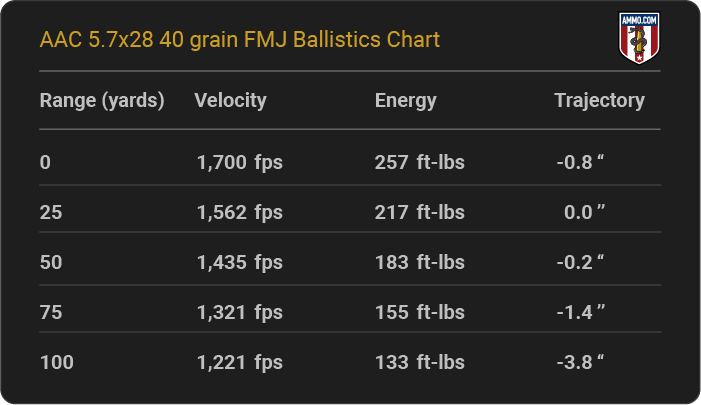
AAC 5.7x28 40 grain V-MAX Ballistics Chart
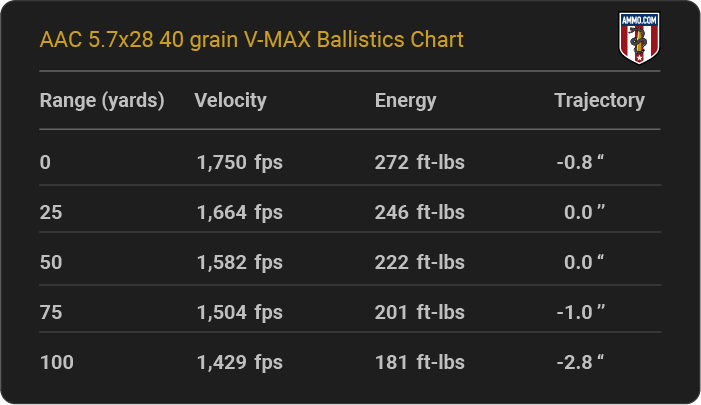
Federal Ammunition Ballistics - FN 5.7x28
Federal American Eagle 5.7x28 40 grain FMJ Ballistics Chart
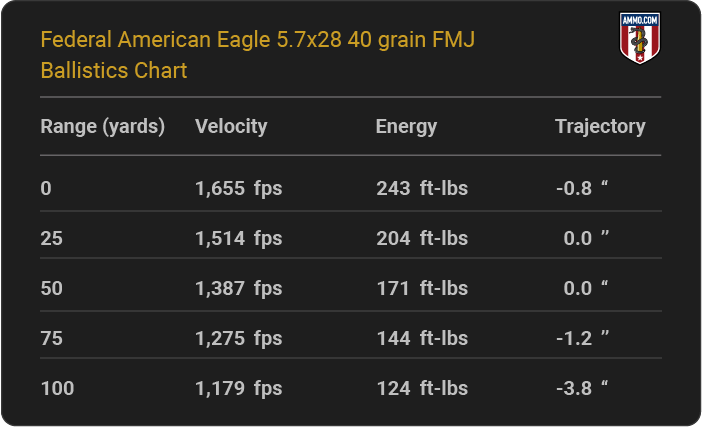
Fiocchi Ammunition Ballistics - FN 5.7x28
Jump to a ballistics chart: Fiocchi Hyperformance 5.7x28 35 grain Jacketed Frangible | Fiocchi Hyperformance 5.7x28 40 grain Tipped HP | Fiocchi Range Dynamice 5.7x28 40 grain FMJ | Fiocchi Range Dynamice 5.7x28 62 grain FMJ
Fiocchi Hyperformance 5.7x28 35 grain Jacketed Frangible Ballistics Chart
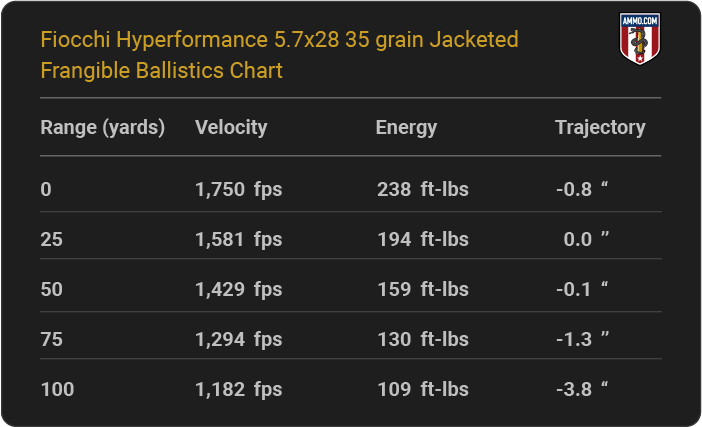
Fiocchi Hyperformance 5.7x28 40 grain Tipped HP Ballistics Chart

Fiocchi Range Dynamice 5.7x28 40 grain FMJ Ballistics Chart
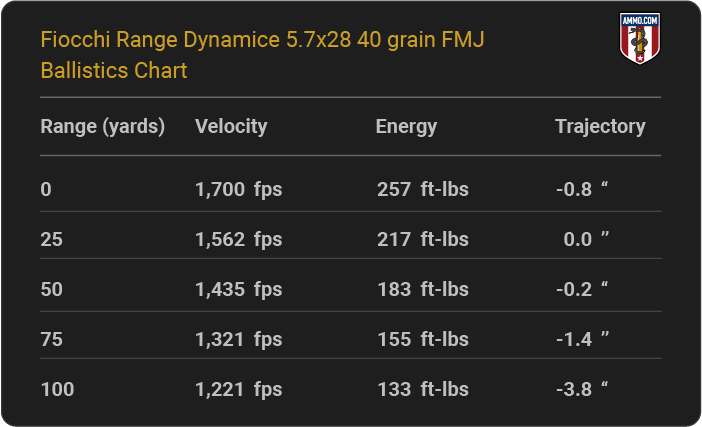
Fiocchi Range Dynamice 5.7x28 62 grain FMJ Ballistics Chart
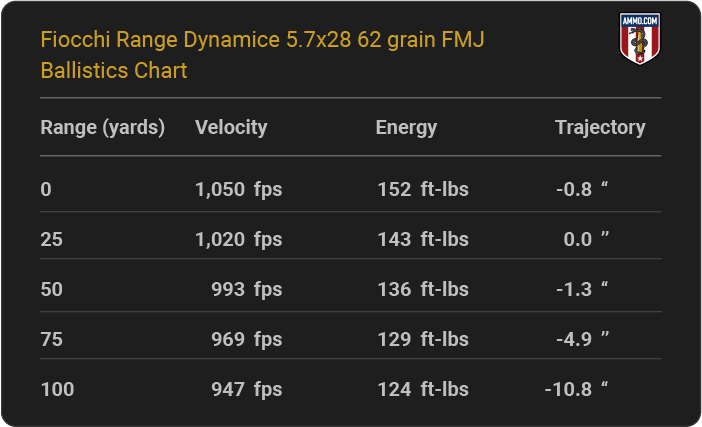
FN Herstal Ammunition Ballistics - FN 5.7x28
Jump to a ballistics chart: FN Herstal SS198LF 5.7x28 27 grain JHP | FN Herstal SS195LF 5.7x28 27 grain Aluminum Core HP | FN Herstal DFNS SS200 5.7x28 30 grain JHP | FN Herstal GUNR SS201 5.7x28 40 grain FMJ | FN Herstal SS197SR 5.7x28 40 grain V-MAX
FN Herstal SS198LF 5.7x28 27 grain JHP Ballistics Chart
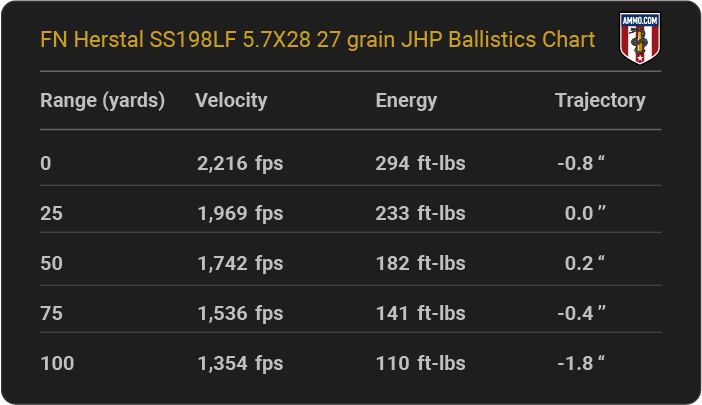
FN Herstal SS195LF 5.7x28 27 grain Aluminum Core HP Ballistics Chart
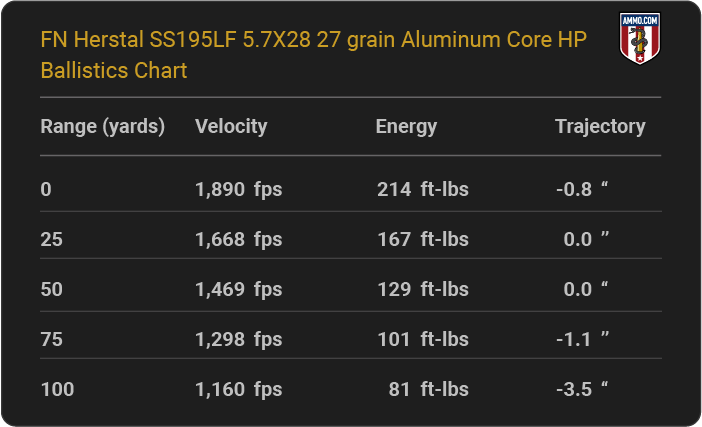
FN Herstal DFNS SS200 5.7x28 30 grain JHP Ballistics Chart

FN Herstal GUNR SS201 5.7x28 40 grain FMJ Ballistics Chart

FN Herstal SS197SR 5.7x28 40 grain V-MAX Ballistics Chart

Speer Ammunition Ballistics - FN 5.7x28
Speer Gold Dot 5.7x28mm 40 grain JHP Ballistics Chart
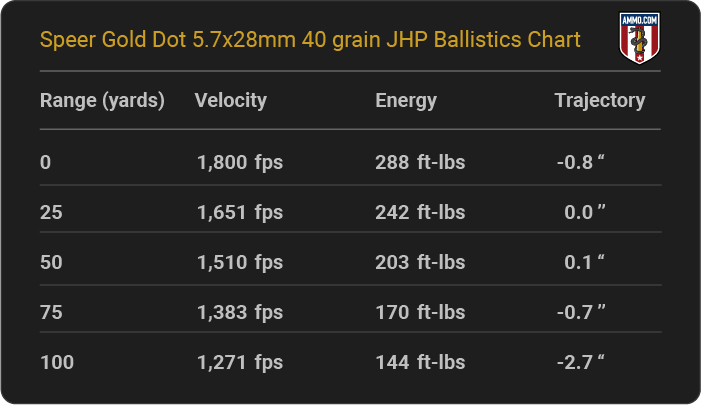
5.7x28 Ballistics Trajectory Chart
Use this chart to explore the incredibly flat trajectory of the 5.7x28.
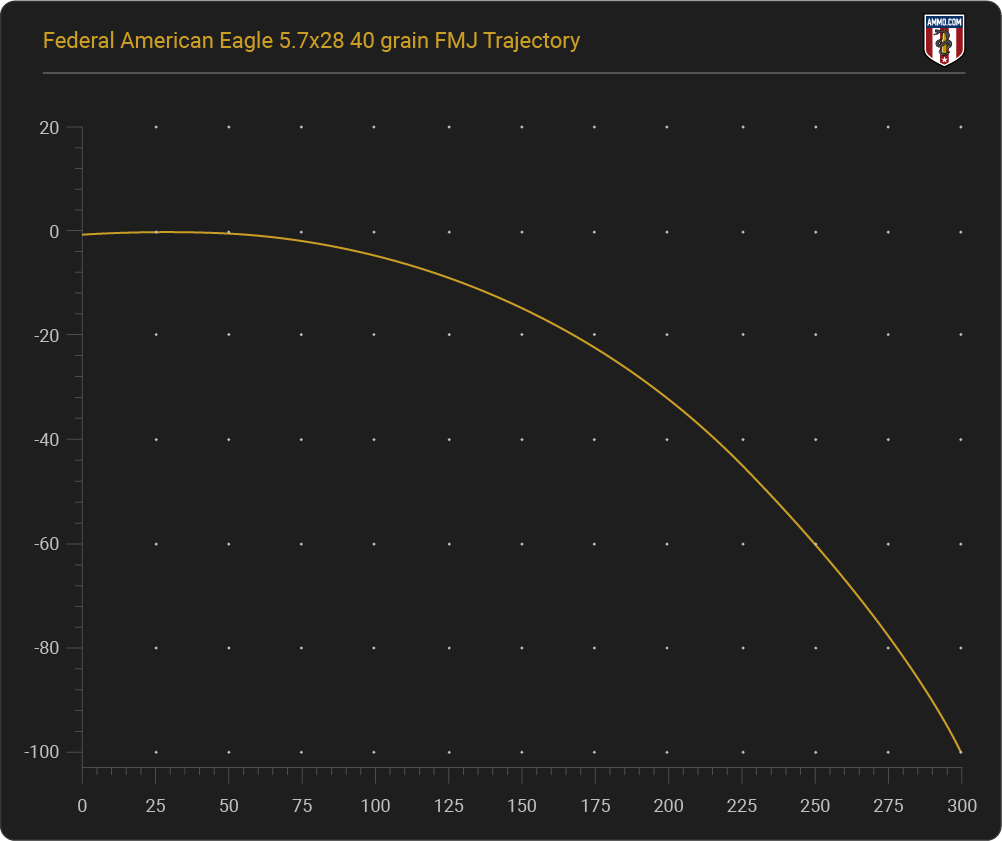
Why Is the 5.7X28 So Popular?
The 5.7x28 hit the scene in 1990. NATO was looking for a new alternative to the 9mm that had a flatter trajectory and better terminal performance. Fortunately, FN Herstal (FNH) developed the cartridge using a custom parent case and a 0.224” diameter projectile. The cartridge became a popular option for law enforcement agencies and civilians for many reasons.
The 5.7x28 is known for its high muzzle velocity and muzzle energy, low likelihood of overpenetration, high magazine capacity, exceptionally high muzzle velocity, and excellent ammo availability. It’s a potentially armor-piercing caliber (the SS190 FMJ in an FN Five-SeveN, which is only available for law enforcement), and it’s available in a wide array of appealing firearms like semi-automatic handguns, carbine rifles, and submachine guns.
While you probably won’t pierce body armor with the civilian semi-auto firearms and ammunition, and the terminal performance isn’t comparable to the 5.56 NATO or fellow .22 caliber .223 Remington, the 5.7x28 is quite handy and certainly fun.
Of course, you can increase the terminal ballistics with JHPs (jacketed hollow points) and the widely available Hornady V-Max bullets, so there are a lot of appealing attributes.
Ultimately, the 5.7x28 will work as a self-defense tool (even the civilian Kel-Tec P50 or carbine FN PS90 with a 16-inch barrel length), it’s fun to shoot with low-recoil, and the ammo availability is reasonable, so it’s an appealing caliber to many shooters. It’s also a decent home defense solution that’s especially appealing for its reduced overpenetration risk.
On the other hand, 5.7x28 firearms are pricier than other centerfire options on the market. For example, the FN Five-SeveN pistol sells for more than $1,000. You could get two Glock 19s for that price.
How the 5.7x28 Ballistics Compare to Other Rifle and Handgun Calibers
The distance a bullet travels, its trajectory, and the terminal performance depend on many factors. From the firearm to the bullet weight and even the design, the results will vary greatly. Fortunately, we can compare the 5.7x28 to another 0.224” diameter bullet, the .223 Remington.
Both cartridges have a similar projectile, but it’s the case that makes all the difference here. The case length (and overall length) of the .223 Rem is substantially larger than the 5.7x28. This means the .223 Rem has more muzzle energy and muzzle velocity. So, it travels much further than the 5.7x28.
Furthermore, the .223 Rem has heavier projectiles with a higher ballistic coefficient (heavier projectiles resist wind drift better). This means that .223 Rem will have a much flatter trajectory. The 5.7x28 also doesn’t have comparable terminal performance. The .223 Rem has a lot more energy and, therefore, more energy transfer (stopping power).
On the other hand, if we compare the 5.7x28 to 9mm, the smaller projectile actually has a flatter trajectory and goes a bit further. The effective range of the 5.7x28 is about 100 yards, compared to that of the 9mm, which is 50 yards max.
Frequently Asked Questions
Below, the team at Ammo.com has gathered and answered some of the most commonly asked questions regarding 5.7x28 ballistics.
What is the effective range of a 5.7x28?
The effective range of the 5.7x28 is about 100 yards.
Is a 5.7x28mm more powerful than a 9mm?
No. The 9x19 Parabellum typically has more muzzle energy than the 5.7x28 (depending on the handgun cartridge). However, it isn’t as much of a difference as some might expect.
What caliber is a 5.7x28 comparable to?
The 5.7x28 is often compared to the 9x19 Parabellum (also known as the 9x19 Luger and 9mm).
What is a 5.7x28 round good for?
FN Herstal designed this caliber for terminal performance and ballistics. It’s great for self-defense, home defense, varmints, and target shooting.
What are the typical muzzle velocity and energy for a 5.7x28mm cartridge?
It starts out with a high velocity of over 1,700 fps (feet per second) and muzzle energy of more than 195 ft-lbs (foot-pounds) on average.
How does the 5.7x28mm perform in terms of penetration and stopping power?
It won’t penetrate as deeply as a Glock 19 (9mm) or a Colt 1911 (.45 ACP), and the cartridges available to civilians won’t pierce body armor, but it will still stop threats if shot placement is adequate.
How does the 5.7x28mm perform in terms of expansion compared to other handgun calibers?
Ammunition manufacturers are focused on increasing the effectiveness of the 5.7x28 as a PDW (personal defense weapon), so rounds like the FN Herstal JHP will expand on impact by design.
What are the terminal ballistics characteristics of the 5.7x28mm round?
The 5.7x28’s terminal ballistics are quite impressive, depending on your setup and the ammo you’re using (suppressors, barrel length, etc.). However, gelatin tests prove any of it is capable of creating sufficient wound cavities. But only the SS190 can pierce Level IIIA Kevlar.
Ballistic Charts
- 308 Ballistics Charts
- 6mm ARC Ballistic Charts
- 10mm Auto Ballistics Charts
- 224 Valkyrie Ballistics Charts
- 204 Ruger Ballistics Charts
- 30-30 Ballistics Charts
- 6.8 SPC Ballistics Charts
- 350 Legend Ballistics Charts
- 300 Blackout Ballistics Charts
- FN 5.7x28 Ballistic Charts
- 7.62x39 Ballistics Charts
- 22 Creedmoor Ballistics Charts
- 300 PRC Ballistics Charts
- .360 Buckhammer Ballistics Charts
- 8.6 Blackout Ballistics Charts
- 30-06 Ballistics Charts
- 44 Magnum Ballistics Charts
- 7mm-08 Ballistics Charts
- 7mm Rem Mag Ballistics Charts
- 300 Win Mag Ballistics Charts
- 270 Win Ballistics Charts
- 45 Long Colt Ballistics Charts
- 6.5 Creedmoor Ballistics Charts
- 40 S&W Ballistics Charts
- 243 Win Ballistics Charts
- 357 Magnum Ballistics Charts
- 380 ACP Ballistics Charts
- 45 ACP Ballistics Charts
- 223 Rem Ballistics Charts
- 450 Bushmaster Ballistics Charts
- 400 Legend Ballistics Charts
- 5.56 Ballistics Charts
- 9mm Ballistics Charts
- 28 Nosler Ballistics Charts
- 45-70 Ballistics Charts
- 6.5 PRC Ballistics Charts
- 22-250 Ballistics Charts
- 22 Hornet Ballistics Charts
- 7mm PRC Ballistics Charts
- 22 ARC Ballistics Charts
- 6.8 Western Ballistics Charts
